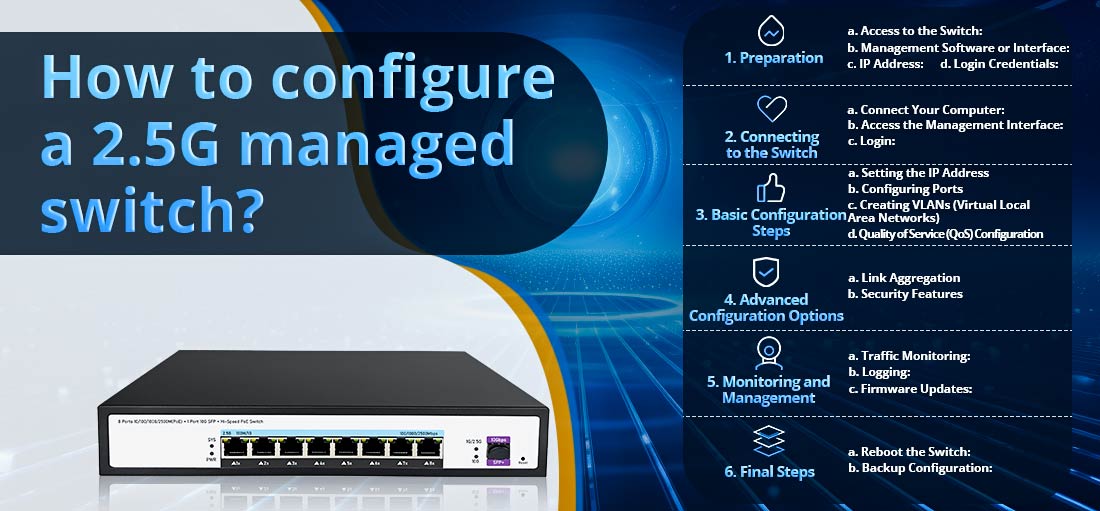
Configuring a 2.5G managed switch involves several steps, including accessing the switch's management interface, setting up network parameters, configuring ports, and implementing features such as VLANs and QoS (Quality of Service). Here’s a detailed guide on how to configure a managed switch:
1. Preparation
Before you begin the configuration, ensure you have the following:
Access to the Switch: Know how to connect to the switch—usually via an Ethernet cable.
Management Software or Interface: This could be a web interface, command-line interface (CLI), or dedicated management software provided by the manufacturer.
IP Address: Identify the switch’s default IP address (usually found in the manual) or set a static IP address on your computer within the same subnet.
Login Credentials: Default username and password for accessing the management interface (these should also be in the manual).
2. Connecting to the Switch
1.Connect Your Computer:
--- Plug one end of an Ethernet cable into your computer and the other end into one of the switch’s ports.
2.Access the Management Interface:
--- Open a web browser (for web interfaces) or a terminal program (for CLI access).
--- Enter the switch’s default IP address into the browser or use SSH/Telnet for CLI access.
3.Login:
--- Enter the default username and password. It’s advisable to change these credentials immediately after logging in for security purposes.
3. Basic Configuration Steps
A. Setting the IP Address
1.Navigate to the Network Settings:
--- Locate the “Network” or “IP Configuration” section in the management interface.
2.Assign an IP Address:
--- Set a static IP address for the switch that falls within your network’s range. Make sure it doesn’t conflict with other devices.
--- Configure the subnet mask and default gateway, ensuring they align with your network’s settings.
3.Save Settings:
--- Apply and save the configuration. This may require a reboot of the switch.
B. Configuring Ports
1.Access the Port Configuration Section:
--- Look for the “Port Management” or “Interface” section.
2.Set Port Speed:
--- Ensure the port speed is set to 2.5 Gbps. Some switches may automatically detect the speed, but you can manually set it if needed.
3.Enable/Disable Ports:
--- Activate or deactivate specific ports based on your requirements. Ensure ports connected to devices are enabled.
4.Port Descriptions:
--- Optionally, add descriptions to ports for easier identification later (e.g., “Office PC,” “Server,” etc.).
5.Save Changes:
--- Apply any changes made to the port settings.
C. Creating VLANs (Virtual Local Area Networks)
1.Navigate to the VLAN Configuration Section:
--- Look for “VLAN” or “VLAN Management.”
2.Create a New VLAN:
--- Specify a VLAN ID (e.g., 10) and a name (e.g., “Guest Network”).
3.Assign Ports to VLANs:
--- Assign specific switch ports to the newly created VLAN. This isolates traffic and improves network security.
4.Configure VLAN Settings:
--- Set the VLAN type (e.g., access or trunk) depending on your network setup. Access ports connect end devices, while trunk ports carry multiple VLANs.
5.Save Configuration:
--- Apply and save the VLAN settings.
D. Quality of Service (QoS) Configuration
1.Access QoS Settings:
--- Find the “QoS” or “Traffic Management” section.
2.Enable QoS:
--- Activate QoS settings to prioritize critical traffic (e.g., VoIP, video streaming).
3.Set Prioritization Rules:
--- Define rules based on MAC addresses, IP addresses, or port numbers to specify which traffic types should receive higher priority.
4.Save QoS Configuration:
--- Ensure any changes are saved.
4. Advanced Configuration Options
A. Link Aggregation
1.Access Link Aggregation Settings:
--- Find the “Link Aggregation” section.
2.Select Ports for Aggregation:
--- Choose the ports you want to aggregate to increase bandwidth between the switch and connected devices.
3.Configure LACP (Link Aggregation Control Protocol):
--- Enable LACP if supported, which allows dynamic link aggregation.
4.Save Configuration:
--- Apply and save the link aggregation settings.
B. Security Features
1.Set Port Security:
--- Navigate to the port security settings to restrict access to specific MAC addresses.
2.Configure Access Control Lists (ACLs):
--- Define rules to control which devices or types of traffic can access specific VLANs or ports.
3.Enable Storm Control:
--- Prevent broadcast, multicast, or unicast storms by setting thresholds for traffic types.
5. Monitoring and Management
Traffic Monitoring: Access the monitoring section to view real-time traffic statistics, port utilization, and error rates.
Logging: Enable logging features to keep track of network events and potential issues.
Firmware Updates: Check for firmware updates regularly to enhance performance and security.
6. Final Steps
Reboot the Switch: After making significant changes, a reboot may be necessary to apply all settings properly.
Backup Configuration: Once configured, save a backup of the current settings. This ensures you can quickly restore configurations if needed.
Conclusion
Configuring a 2.5G managed switch allows for tailored network management, enhanced performance, and security features essential for modern networking needs. By following these steps, you can set up your switch to meet your specific requirements, ensuring a robust and efficient network environment. Remember to document your configuration settings and regularly monitor the network for optimal performance and security.